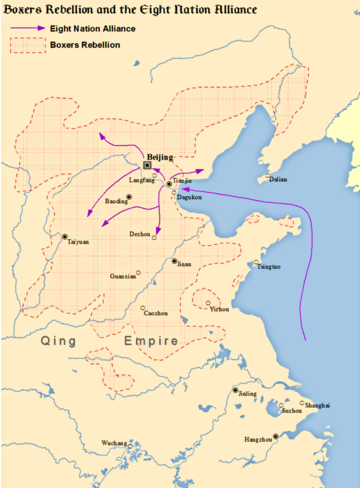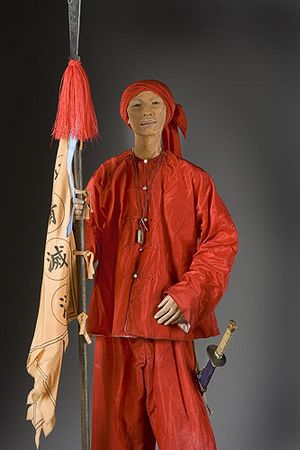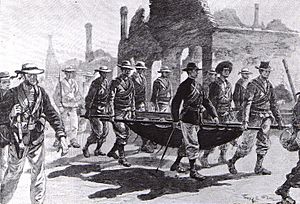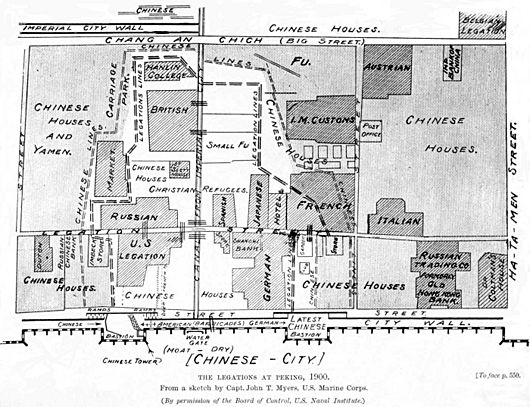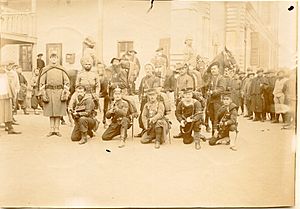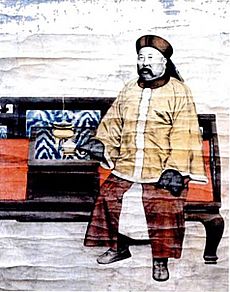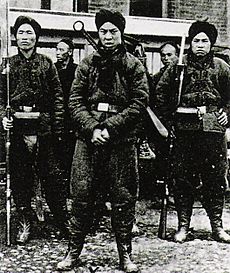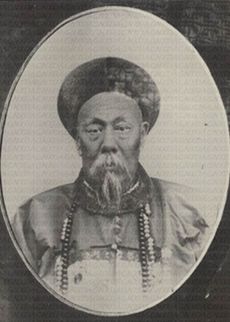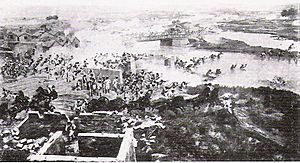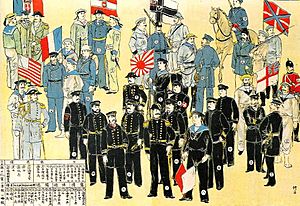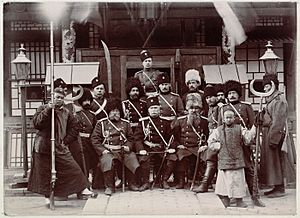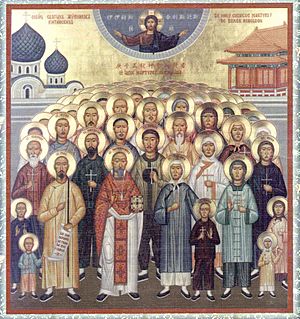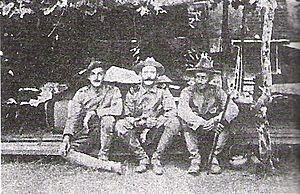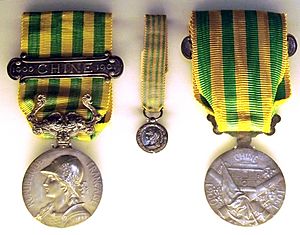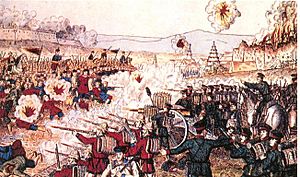Boxer Rebellion facts for kids
Quick facts for kids Boxer Rebellion |
|||||||
|---|---|---|---|---|---|---|---|
| Part of the Century of humiliation | |||||||
 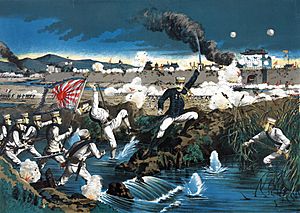 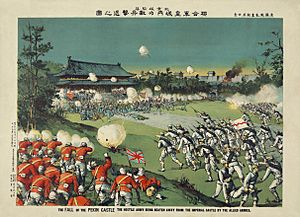 Top: US troops scale the walls of Beijing Middle: Japanese soldiers in the Battle of Tientsin Bottom: British and Japanese soldiers in the Battle of Beijing |
|||||||
|
|||||||
| Belligerents | |||||||
Eight-Nation Alliance
|
|||||||
| Commanders and leaders | |||||||
| Legations: Seymour Expedition: Gaselee Expedition: Occupation of Manchuria: Mutual Protection of Southeast China: |
Boxers: Qing dynasty: Commander in Chief: Hushenying: Tenacious Army: Resolute Army: Gansu Army: |
||||||
| Strength | |||||||
| Seymour Expedition: 2,100–2,188 Gaselee Expedition: 18,000 China Relief Expedition: 2,500 Russian army in Manchuria: 100,000–200,000 |
|
||||||
| Casualties and losses | |||||||
| 32,000 Chinese Christians and 200 Western missionaries killed by Chinese Boxers in Northern China 100,000 total deaths in the conflict (both civilian and military included) |
|||||||
| Boxer Rebellion | |||||||||
|---|---|---|---|---|---|---|---|---|---|
| Traditional Chinese | 義和團運動 | ||||||||
| Simplified Chinese | 义和团运动 | ||||||||
| Literal meaning | Militia United in Righteousness Movement | ||||||||
|
|||||||||
The Boxer Rebellion, also known as the Boxer Uprising, was a major event in China between 1899 and 1901. It happened near the end of the Qing dynasty, China's last royal family. This uprising was against foreign influence, colonial rule, and Christian missionaries in China.
The people leading this movement were called the "Boxers" in English. Their real name was the Society of Righteous and Harmonious Fists. They got the name "Boxers" because many members practiced Chinese martial arts, which people at the time called "Chinese boxing."
After a war with Japan in 1895, people in northern China worried about foreign countries taking more control. They also didn't like how Christian missionaries were given special rights. In 1898, northern China faced natural disasters like floods and droughts. The Boxers blamed these problems on foreign and Christian influences.
Starting in 1899, the Boxers became violent in areas like Shandong. They destroyed foreign property, such as railroads. They also attacked or killed Christian missionaries and Chinese people who had become Christians. By June 1900, the situation was very tense. Boxer fighters, believing they couldn't be harmed by foreign weapons, gathered in Beijing. Their main slogan was "Support the Qing government and exterminate the foreigners."
Diplomats, missionaries, soldiers, and some Chinese Christians sought safety in the special area for foreign offices in Beijing. The Boxers then surrounded this area. An Eight-Nation Alliance of soldiers from eight countries, including America, Britain, and Japan, came to China. Their goal was to end the siege. On June 17, they attacked the Dagu Fort near Tianjin.
The Empress Dowager Cixi, who ruled China, first hesitated but then supported the Boxers. On June 21, she declared war on the foreign powers. However, Chinese officials were divided. Some supported the Boxers, while others wanted peace. Officials in the southern provinces ignored the Empress's order to fight foreigners.
The Eight-Nation Alliance brought 20,000 troops to China. They defeated the Chinese army in Tianjin and reached Beijing on August 14. This ended the fifty-five-day siege of the foreign offices. After the siege, there was widespread looting in Beijing. People suspected of being Boxers were punished. The Boxer Protocol was signed on September 7, 1901. This agreement required China to punish officials who supported the Boxers. It also allowed foreign troops to stay in Beijing. China had to pay a huge amount of silver as a penalty over 39 years. The Boxer Rebellion greatly weakened the Qing dynasty. It led to major changes in the Chinese government later on.
Contents
- Understanding the Boxer Uprising
- Chinese Forces in the Conflict
- The Boxer War Begins
- Russian Actions in Manchuria
- Impact on Missionaries and Chinese Christians
- What Happened Next
- Lasting Effects of the Rebellion
- How We Talk About the Boxer Uprising
- The Boxer Uprising in Media
- Images for kids
- See also
Understanding the Boxer Uprising
Who Were the Boxers?
The group known as the Righteous and Harmonious Fists started in the northern province of Shandong. This area had a history of social problems and different religious groups. American Christian missionaries were likely the first to call these young, athletic men "Boxers." They used this name because of the Chinese martial arts and weapons training the men practiced.
A key part of their practice was a type of Chinese spirit possession. This involved spinning swords, bowing down, and chanting to gods. Many unemployed young men, including teenagers, were drawn to the idea of fighting against Western influence. They believed they were safe from modern weapons. The Boxers, using rifles and swords, claimed they could not be harmed by bullets or knives. They also believed that millions of soldiers from heaven would help them free China from foreign control.
Why the Conflict Started
Tensions grew as foreign powers gained more control in China in the late 1800s. People felt angry about this foreign influence. Also, severe weather, like droughts and floods in Shandong in 1897–98, forced farmers to leave their homes. They had to go to cities to find food.
A big reason for the anger in northern China was the work of missionaries. Treaties signed after the Second Opium War in 1860 allowed foreign missionaries to preach anywhere in China. They could also buy land for churches. On November 1, 1897, some armed men attacked a German missionary's home and killed two priests. This event is known as the Juye Incident.
When Germany's leader, Kaiser Wilhelm II, heard about these deaths, he sent ships to take over Jiaozhou Bay. This led to other European countries and Japan also taking control of parts of China. Germany gained control over loans, mining, and railways in Shandong. Russia took influence north of the Great Wall of China. France gained influence in southern provinces, and Japan in Fujian. Britain gained influence over the Yangtze River Valley. These actions made many Chinese people fear that foreigners were trying to colonize China piece by piece.
In October 1898, Boxers attacked a Christian village where a temple had become a church. This was the first time the Boxers used their famous slogan: "Support the Qing, destroy the foreigners." One year later, in October 1899, they called themselves the "Militia United in Righteousness." They used "Militia" to sound more official and less like a forbidden group.
Foreign diplomats reacted strongly to attacks on missionaries and Christians. In 1899, the French helped Catholic priests gain official status. This allowed local priests to help their followers in legal problems, bypassing local Chinese officials. Many Chinese worried that foreign missionaries were part of a plan to divide China. One Chinese official said, "Take away your missionaries and your opium and you will be welcome."
The Boxer movement grew during the Hundred Days' Reform in 1898. During this time, some Chinese officials tried to make big changes to the government. This angered many conservative officials. The Empress Dowager Cixi stopped these reforms. The failure of these reforms made many educated Chinese lose faith in the Qing government. People widely believed that foreign actions caused China's problems.
Chinese Forces in the Conflict
The Chinese army had been weakened by the war with Japan in 1895. They were just starting to reform when the Boxer Rebellion began. Most of the fighting was done by troops already in the Zhili area. Soldiers from other provinces arrived later.
Chinese forces struggled against the international army. This was because they had little time to reform. Also, China's best troops were not sent to fight. Chinese officers often lacked basic knowledge of how to plan battles. Soldiers were not very good at shooting accurately. Cavalry was poorly organized. However, Chinese artillery was very good. It caused many more injuries than the infantry in Tianjin. Chinese soldiers were also praised for using cover well and for their strong defenses.
The Boxer War Begins
Growing Tensions
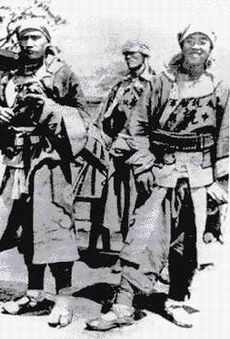
In January 1900, Empress Dowager Cixi changed her mind about the Boxers. She issued orders to protect them, which angered foreign powers. By spring 1900, the Boxer movement quickly spread near Beijing. Boxers burned Christian churches and killed Chinese Christians. They also scared Chinese officials who tried to stop them. An American official reported that the country was full of "hungry, discontented, hopeless idlers."
On May 30, foreign diplomats asked for soldiers to come to Beijing to protect their offices. The Chinese government agreed. The next day, 435 navy troops from eight countries arrived by train. They set up defenses around their missions.
On June 5, Boxers cut the railway line to Tianjin, isolating Beijing. On June 11, a Japanese diplomat was attacked and killed by soldiers guarding Beijing's southern gate. These soldiers had threatened foreign offices before.
On June 11, the first Boxer was seen near the foreign offices. A German official captured and executed a Boxer boy. In response, thousands of Boxers entered Beijing that afternoon. They burned many Christian churches and cathedrals. Some victims were burned alive. American and British missionaries took refuge in a mission. Soldiers at the British and German offices shot and killed several Boxers. Chinese soldiers and Boxers then attacked and killed Chinese Christians near the foreign offices.
The Seymour Expedition
As the situation worsened, the foreign powers sent a second force to Beijing on June 10, 1900. This force of 2,000 sailors and marines was led by British Vice Admiral Edward Seymour. The largest group was British. The force traveled by train from Dagu to Tianjin. However, the railway was cut between Tianjin and Beijing. Seymour decided to try to repair the line or walk the rest of the way.
The Chinese court then replaced a peace-minded official with Prince Duan, who was against foreigners and supported the Boxers. He ordered the Chinese army to attack the foreign forces. General Nie Shicheng, confused by orders, let Seymour's army pass by train.
After leaving Tianjin, Seymour's force reached Langfang, but the railway was destroyed there. The force found itself surrounded. They were attacked by Chinese irregulars and Imperial troops. Five thousand of General Dong Fuxiang's "Gansu Braves" and many Boxers defeated Seymour's troops at the Battle of Langfang on June 18.
Seymour's force ran low on food, ammunition, and medical supplies. They found a hidden Chinese weapons storage area. There, they waited for rescue. A Chinese servant managed to get to Tianjin and tell the foreign powers about Seymour's trouble. A relief column of 1,800 men was sent. On June 25, the relief column reached Seymour. Seymour's force destroyed the weapons and marched back to Tianjin on June 26. Seymour's expedition had 62 killed and 228 wounded.
Siege of Beijing's Foreign Offices
On June 15, Chinese forces placed electric mines in the Beihe River to stop foreign ships. With fighting in Tianjin and no communication with Beijing, foreign nations sent more troops. On June 17, they captured the Dagu Forts. When Empress Dowager Cixi heard about the attack on the forts, she ordered foreign diplomats to leave Beijing within 24 hours.
The diplomats met the next morning. Most agreed they could not trust the Chinese army. They feared they would be killed if they left. The German diplomat, Baron Clemens von Ketteler, went to complain to the royal court. On his way, he was killed by a Chinese captain. His aide escaped and reported the death. The other diplomats decided to stay and defend their offices.
Most foreign civilians, including missionaries and business people, took shelter in the British office. Chinese Christians stayed in a nearby palace. The Northern Cathedral was also under siege. It was defended by 43 French and Italian soldiers, 33 Catholic priests and nuns, and about 3,200 Chinese Catholics. They suffered many losses due to lack of food and Chinese mines dug under the building.
On June 21, Empress Dowager Cixi ordered the Chinese army to join the Boxers in attacking foreign troops. This was like a declaration of war. However, regional governors in the south, who had strong armies, refused to follow this order. They kept their forces out of the conflict. This meant most of China's military did not fight against the foreigners.
The foreign offices in Beijing were surrounded by Chinese army and Boxer groups from June 20 to August 14, 1900. About 473 foreign civilians, 409 soldiers, and 3,000 Chinese Christians were trapped there. They defended the area with small guns, three machine guns, and one old cannon. This cannon was called the International Gun because its parts came from different countries. Chinese Christians helped the foreigners use this cannon, which was very important for defense.
On June 22 and 23, Chinese soldiers and Boxers set fire to areas near the British office. This was meant to scare the defenders. The Hanlin Academy, a famous library with ancient Chinese books, caught fire. Both sides blamed each other for its destruction.
After failing to burn out the foreigners, the Chinese army built barricades closer to the foreign lines. They slowly pushed the foreign guards back. This tactic was used especially in the palace where most Chinese Christians were staying. Gunfire and firecrackers were aimed at the offices almost every night, but caused little damage. Sniper fire did harm the foreign defenders. Despite having more soldiers, the Chinese did not try a direct attack on the foreign offices.
The Germans and Americans held a very important position on the Tartar Wall. Holding this tall and wide wall was vital. On June 30, the Chinese pushed the Germans off the wall, leaving only American Marines to defend it. A Chinese barricade was built very close to the American positions. On July 3, 56 British, Russian, and American marines and sailors attacked the Chinese barricade on the wall. They surprised the Chinese, killed about 20, and forced them to retreat. The Chinese did not try to advance on the wall again.
July 13 was a very difficult day for the defenders. The Japanese and Italians were pushed back to their last defense line. The Chinese exploded a mine under the French office. On July 16, a skilled British officer was killed. But an American official made contact with the Chinese government, and a ceasefire was declared on July 17.
Conflicting Orders in Beijing
Inside Beijing, Chinese officials had different ideas. General Ronglu believed it was useless to fight all foreign powers at once. He refused to let Prince Duan, an anti-foreign official, use artillery to destroy the foreign offices. Ronglu forced General Dong Fuxiang's troops to pull back from attacking the offices. This saved the foreigners. Ronglu and Prince Qing also sent food to the foreign offices. They used their own soldiers to fight against Dong Fuxiang's Muslim Gansu Braves and the Boxers who were attacking the foreigners.
Ronglu also hid an order from General Nie Shicheng. This order told Nie to stop fighting the Boxers because of the foreign invasion. Because of Ronglu's actions, General Nie continued to fight the Boxers. He killed many of them even as foreign troops entered China. Ronglu also ordered Nie to protect foreigners and the railway from the Boxers. This helped the foreign army move quickly into China. General Nie used thousands of troops against the Boxers instead of against the foreigners. At the Battle of Tianjin, General Nie chose to sacrifice his life by walking into the range of Allied guns.
Some Chinese officials, like Xu Jingcheng, argued that killing foreign diplomats was wrong. Xu and five others asked Empress Dowager Cixi to stop the Boxers and make peace. The Empress Dowager was angry and sentenced Xu and the others to death.
The situation in Beijing was confusing. The foreign offices were surrounded by both Chinese imperial troops and Gansu forces. Dong Fuxiang's army, which included Boxers, wanted to keep attacking. But Ronglu's imperial forces tried to protect the foreign offices. However, to please conservative officials, Ronglu's men also fired at the offices and set off firecrackers to make it seem like they were attacking. The foreigners inside the offices fired at anyone they saw, including messengers and civilians. Dong Fuxiang was not given the artillery he needed to destroy the offices. The foreign alliance later found many unused Chinese cannons after the siege ended.
The Gaselee Expedition
| Forces of the Eight-Nation Alliance Relief of the Legations 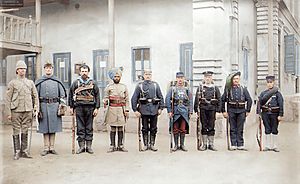 left to right: Britain, United States, Australia, India, Germany, France, Austria-Hungary, Italy, Japan |
|||
| Countries | Warships (units) |
Marines (men) |
Army (men) |
|---|---|---|---|
| 18 | 540 | 20,300 | |
| 10 | 750 | 12,400 | |
| 8 | 2,020 | 10,000 | |
| 5 | 390 | 3,130 | |
| 2 | 295 | 3,125 | |
| 5 | 600 | 300 | |
| 2 | 80 | 2,500 | |
| 4 | 296 | unknown | |
| Total | 54 | 4,971 | 51,755 |
Foreign navies began to gather along China's northern coast in April 1900. Several international forces were sent to Beijing. The Chinese forces were eventually defeated by the Eight-Nation Alliance. This alliance included soldiers from Austria-Hungary, France, Germany, Italy, Japan, Russia, the United Kingdom, and the United States. The Netherlands also sent ships to protect its citizens in Shanghai.
British Lieutenant-General Alfred Gaselee led the Eight-Nation Alliance, which grew to 55,000 soldiers. The largest groups were Japanese (20,840), Russian (13,150), and British (12,020). The "First Chinese Regiment," made of Chinese soldiers serving the British, was praised for its fighting. Important events included capturing the Dagu Forts and four Chinese destroyers. A young American mining engineer named Herbert Hoover, who later became a U.S. President, was among the foreigners trapped in Tianjin.
The international force finally captured Tianjin on July 14. They suffered their heaviest losses of the Boxer Rebellion in the Battle of Tianjin. From Tianjin, the international force marched to Beijing, about 120 km away, with 20,000 allied troops. On August 4, there were about 70,000 Chinese imperial troops and 50,000 to 100,000 Boxers along the way. The allies met little resistance, fighting battles at Beicang and Yangcun. At Yangcun, U.S. and British troops led the attack. The hot, humid weather was a big problem. Temperatures reached 42°C. Many soldiers became dehydrated. Chinese villagers sometimes attacked Allied troops looking for water.
The international force reached Beijing on August 14. The Chinese government had invested in modernizing its army after the First Sino-Japanese War. They had modern rifles and artillery. Three modern divisions protected Beijing. Two were led by anti-Boxer officials, while Prince Duan led the "Tiger Spirit Division," which joined the Gansu Braves and Boxers. This division's captain had killed the German diplomat. The Tenacious Army, trained by German and Russian officers, fought well at Tianjin. The Gansu Braves, though not as well-trained, were armed with modern weapons. They led the defeat of the Alliance at Langfang and were the most fierce in attacking the foreign offices in Beijing.
The British army was the first to reach the besieged foreign offices on the afternoon of August 14. The U.S. played a role because its ships and troops were in Manila after the Spanish–American War. In the U.S. military, this action was called the China Relief Expedition. American Marines climbing the walls of Beijing is a famous image from the Boxer Rebellion.
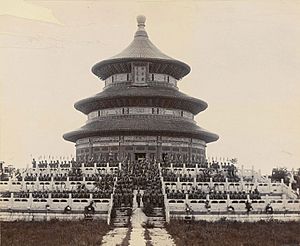
The British Army reached the foreign offices on the afternoon of August 14, ending the siege. The Northern Cathedral was relieved on August 16, first by Japanese soldiers, then officially by the French.
Qing Court Leaves Beijing
In the early hours of August 15, as the foreign offices were being rescued, Empress Dowager Cixi, the Guangxu Emperor, and a small group escaped Beijing. They dressed simply and traveled in ox carts. Legend says the Empress Dowager ordered the Emperor's favorite concubine, Consort Zhen, to be thrown down a well. The journey was hard because they left quickly. The Empress Dowager insisted it was a "tour of inspection," not a retreat. After weeks of travel, they reached Xi'an in Shaanxi province. This area was safe behind mountains and protected by the Gansu Braves. The foreign forces had no orders to follow the Empress Dowager, so they stayed in Beijing.
Russian Actions in Manchuria
Russia and China had been at peace for a long time. But Russian forces took advantage of China's defeats to gain Chinese land in Manchuria in 1858 and 1860. Russia wanted control over the Amur River for shipping and warm-water ports like Port Arthur. Japan's rise as a power worried Russia, especially its growing influence in Korea. After Japan's victory in the First Sino-Japanese War in 1895, Russia, Germany, and France forced Japan to return land it won. This led to a kind of alliance between China and Russia.
Local Chinese people in Manchuria were angry about Russia's actions. They began to bother Russians and Russian projects, like the Chinese Eastern Railway. In June 1900, the Chinese attacked the Russian town of Blagoveshchensk. The Russian government used the Boxer activity as an excuse to send about 200,000 troops into Manchuria to stop the Boxers. The Chinese destroyed a railway bridge and barracks on July 27. The Boxers also destroyed railways and telegraph lines.
The Chinese Honghuzi bandits in Manchuria, who fought with the Boxers, continued their attacks against the Russian occupation even after the Boxer Rebellion ended. They fought until Russia was defeated by Japan in the Russo-Japanese war.
Impact on Missionaries and Chinese Christians
Many missionaries and their Chinese followers were killed across northern China. Some were killed by Boxers, others by government troops. After China declared war in June 1900, Yuxian, the governor of Shanxi, began a harsh policy against foreigners and Christians. On July 9, reports said he executed 44 foreigners, including women and children, from missionary families. He had invited them to the capital, promising protection. This event became a symbol of Chinese anger, known as the Taiyuan Massacre. By the end of the summer, more foreigners and up to 2,000 Chinese Christians had been killed in Shanxi.
Overall, during the Boxer Rebellion, 136 Protestant missionaries and 53 children were killed. Also, 47 Catholic priests and nuns, 30,000 Chinese Catholics, 2,000 Chinese Protestants, and 200 to 400 Russian Orthodox Christians were estimated to have been killed. The Protestant dead are known as the China Martyrs of 1900. The Boxers killed Christians in 26 different areas.
What Happened Next
Paying for the Damage
After foreign armies captured Beijing, some of Empress Dowager Cixi's advisors wanted to keep fighting. They believed China could still win. However, Empress Dowager Cixi was practical. She decided to agree to the peace terms because she was promised she could remain in power. Also, China would not have to give up any land.
On September 7, 1901, the Qing court signed the "Boxer Protocol" (Peace Agreement). This agreement ordered the execution of 10 high-ranking officials who supported the Boxers. China also had to pay a huge fine of 450,000,000 taels of silver. This payment was to be made over 39 years, ending in 1940. With interest, the total would be 982,238,150 taels. To help pay, China agreed to increase taxes on goods. The amount of the fine was set so that each Chinese person (about 450 million in 1900) would pay one tael. China's customs income and salt taxes were used to guarantee the payment. China paid 668,661,220 taels of silver from 1901 to 1939.
A large part of the money paid to the United States was used to fund education for Chinese students in U.S. universities. This was called the Boxer Indemnity Scholarship Program. An institute was set up to prepare these students. When the first students returned to China, they taught others. This institute later became Tsinghua University.
The China Inland Mission lost many members. However, in 1901, when other nations demanded money from China, Hudson Taylor refused to accept payment for lost property or lives. He wanted to show kindness to the Chinese people.
The Qing government did not agree to all foreign demands. The Manchu governor Yuxian was executed. But the court refused to execute the Han Chinese General Dong Fuxiang, even though he encouraged killing foreigners. Empress Dowager Cixi stepped in. Dong was only removed from his position and sent home. He lived a life of luxury in his home province of Gansu. When he died in 1908, all his honors were given back, and he received a full military burial.
Lasting Effects of the Rebellion
The European powers stopped trying to colonize China. They learned that it was better to work with the ruling dynasty than directly with the Chinese people. They even briefly helped the Qing in a war against Japan to prevent Japan from becoming too powerful in the region.
At the same time, European influence in China began to decline. Japan became more powerful due to its role in the Boxer War and its victory in the First Sino-Japanese War. When the Qing dynasty fell and the Nationalist Kuomintang rose, European power in China became mostly symbolic. After taking over Russian influence in southern Manchuria, Japan became a major military and cultural power in Asia. Many Chinese scholars, like Sun Yat-Sen, who later founded the Kuomintang, studied in Japan.
In October 1900, Russia took over provinces in Manchuria. This worried Britain and America, who wanted China to remain open for trade.
Japan's conflict with Russia over Liaodong and other parts of Manchuria led to the Russo-Japanese War. This happened because Russia refused to leave Manchuria as agreed in the Boxer Protocol. Negotiations failed in February 1904. Russia was eventually defeated by Japan.

Besides the financial penalty, Empress Dowager Cixi reluctantly started some reforms. These "New Policies" began in 1901. The old system of government exams was removed. Education through Chinese classics was replaced with a European-style system leading to university degrees. New military and police groups were formed. The government also simplified its structure and started to change tax policies. After Cixi and the Guangxu Emperor died in 1908, the prince regent Zaifeng continued these reforms.
The Boxer Rebellion weakened the Qing dynasty and China's ability to defend itself. The government was temporarily supported by the Europeans. The conflict also deepened differences between anti-foreign royalists in northern China and anti-Qing revolutionaries in the south. This situation led to a chaotic period of warlord eras in China. The northern warlords were against the southern revolutionaries, who overthrew the Qing monarchy in 1911. This rivalry was not fully resolved until the northern warlords were defeated by the Kuomintang in 1926–28. Before the Boxer Rebellion, all anti-Qing movements, like the Taiping Rebellion, had been stopped by the Qing.
During the Second Sino-Japanese War, the Japanese asked the Muslim general Ma Hongkui to join them. He refused, saying his relatives, including his uncle Ma Fulu, were killed during the Battle of Peking. Since Japanese troops were a large part of the foreign forces, he would not cooperate with them.
How We Talk About the Boxer Uprising
The name "Boxer Rebellion" is not quite right, according to historian Joseph W. Esherick. He says the Boxers "never rebelled against the Manchu rulers of China." Their main slogan was "support the Qing, destroy the Foreign." "Foreign" meant Christian religion and its Chinese followers, as much as foreigners themselves. After the uprising was stopped, foreign powers and Chinese officials realized the Qing government needed to stay in power to keep order and collect taxes. To save face for the Empress Dowager, everyone said the Boxers were rebels. Esherick believes the term "rebellion" was used for political reasons, but it has stuck around.
On June 6, 1900, The Times newspaper in London used "rebellion" in quotation marks. This suggested they thought Empress Dowager Cixi had actually started the uprising. Other recent works call it the "Boxer Movement" or the "Boxer War." In Chinese, it's called the "Yihetuan Movement." German scholar Thoralf Klein notes that all these terms are later interpretations of the conflict. Each term, like "uprising," "rebellion," or "movement," suggests a different meaning. Even "Boxer War" raises questions because neither side formally declared war. The imperial orders on June 21 said fighting had begun. But the Allied troops acted like they were on a punishment mission, not fighting a declared war.
There are also different names for the fighters. Early reports in 1898 called the village activists "Yihequan." The first use of "Boxer" was in a letter by missionary Grace Newton in September 1899. This shows that "Boxer" was already a known term, probably created by missionaries like Arthur H. Smith or Henry Porter.
The Boxer Uprising in Media

By 1900, new forms of media like illustrated newspapers, magazines, and postcards showed images of the Boxers and the foreign armies. Artists and photographers covered the rebellion. Paintings and prints, including Japanese woodblocks, were also published. In the years that followed, the Boxers were often talked about. Here are some examples:
- In the Polish play The Wedding (1901), a character asks, "How are things in politics, Mister? Are the Chinese holding out firmly!?"
- The novel The Travels of Lao Can by Liu E shows an honest official trying to make changes. It describes the Boxers as religious rebels.
- The 1963 film 55 Days at Peking stars Charlton Heston, Ava Gardner, and David Niven.
- In 1975, Hong Kong's Shaw Brothers studio made the film Boxer Rebellion.
- The Last Empress (2007) by Anchee Min describes the rule of Empress Dowager Cixi. The siege of the foreign offices is a key event in the novel.
- Mo, Yan's novel Sandalwood Death tells the story from the viewpoint of villagers during the Boxer Uprising.
Images for kids
See also
 In Spanish: Levantamiento de los bóxers para niños
In Spanish: Levantamiento de los bóxers para niños
- Battle of Peking (1900)
- Boxer Indemnity Scholarship Program
- Century of humiliation
- China Relief Expedition
- Donghak Rebellion, an anti-foreign, proto-nationalist uprising in pre-Japanese Korea
- Gengzi Guobian Tanci
- Imperial Decree on events leading to the signing of Boxer Protocol
- List of 1900–1930 publications on the Boxer Rebellion
- Xishiku Cathedral


